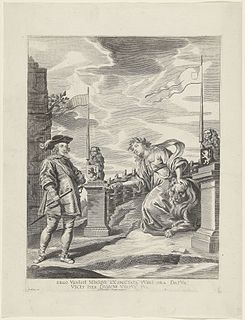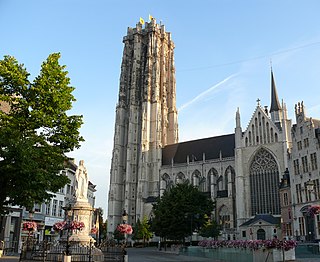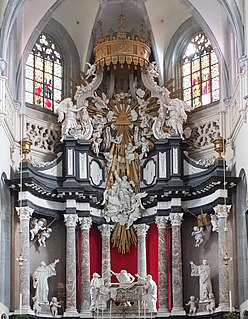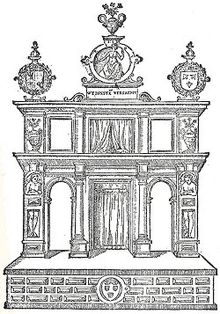Michiel Coxie the Elder, Michiel Coxcie the Elder or Michiel van Coxcie, Latinised name Coxius, was a Flemish painter of altarpieces and portraits, a draughtsman and a designer of stained-glass windows, tapestries and prints. He worked for patrons in the principal cities of Flanders. He became the court painter to successively Emperor Charles V and King Philip II of Spain.

Chambers of rhetoric were dramatic societies in the Low Countries. Their members were called Rederijkers, from the French word 'rhétoricien', and during the 15th and 16th centuries were mainly interested in dramas and lyrics. These societies were closely connected with local civic leaders and their public plays were a form of early public relations for the city.

A Joyous Entry is the official name used for the ceremonial royal entry, the first official peaceable visit of a reigning monarch, prince, duke or governor into a city, mainly in the Duchy of Brabant or the County of Flanders and occasionally in France, Luxembourg, Hungary, or Scotland, usually coinciding with recognition by the monarch of the rights or privileges to the city and sometimes accompanied by an extension of them.

The Guild of Romanists or Confrérie van romanisten was a society which was active in Antwerp from the late 16th to the late 18th century. Its membership was made up of notables and artists from Antwerp who had visited Rome. It offered artists access to the networks of Antwerp's urban elites.

Sebastiaen Vrancx, Sebastiaan Vrancx or Sebastian Vranckx was a Flemish Baroque painter, draughtsman and designer of prints who is mainly known for his battle scenes, a genre that he pioneered in Netherlandish painting. He also created landscapes with mythological and allegorical scenes, scenes with robbers, village scenes and celebrations in cities. He was a gifted figure painter who was regularly invited to paint the staffage in compositions of fellow painters. As an active member of a local chamber of rhetoric, he wrote comedies and a number of poems. He was further captain of the Antwerp civil militia (schutterij).

Marten Ryckaert or Maerten Ryckaert, was a Flemish landscape painter. He was known for his small, usually imaginary landscapes in an Italianate style.

Tobias Verhaecht (1561–1631) was a painter from Antwerp in the Duchy of Brabant who primarily painted landscapes. His style was indebted to the mannerist world landscape developed by artists like Joachim Patinir and Pieter Bruegel the Elder. He was the first teacher of Pieter Paul Rubens.

Willem or Guiliam van Nieulandt, sometimes Nieuwelandt (1584–1635) was a Dutch Golden Age painter, engraver, poet and playwright from Antwerp.

The Violieren was a chamber of rhetoric that dates back to the 15th century in Antwerp, when it was a social drama society with close links to the Guild of Saint Luke. It was one of three drama guilds in the city, the other two being the Goudbloem and the Olyftack. In 1660 the Violieren merged with former rival Olyftack, and in 1762 the society was dissolved altogether.

Bernaert de Rijckere was a Flemish Renaissance painter known for his history paintings and portraits.

Edgard Pierre Jozef Farasyn was a Belgian painter, watercolorist, engraver and etcher who specialized in seascapes, landscapes, genre scenes and interior portraits. In his later life, he became interested in depicting fishermen.

De Olijftak, or in full Gulde van den Heyligen Geest die men noempt den Olijftak was a chamber of rhetoric that dates back to the early 16th century in Antwerp, when it was a social drama society drawing its membership primarily from merchants and tradesmen. In 1660 it merged with its former rival the Violieren, and in 1762 the society was dissolved altogether.

WillemOgier (1618–1689) was a Flemish schoolmaster, playwright and comedian.
Events from the 1580s in the Spanish Netherlands and Prince-bishopric of Liège.

The Archdiocese of Mechelen–Brussels is a Latin Church ecclesiastical territory or archdiocese of the Catholic Church in Belgium. It is the primatial see of Belgium and the centre of the Ecclesiastical Province governed by the Archbishop of Mechelen-Brussels, which covers the whole of Belgium. It was formed in 1559 and the bishop has a seat in two cathedrals, St. Rumbold's Cathedral in Mechelen and the Cathedral of St. Michael and St. Gudula in Brussels. The current archbishop is Jozef De Kesel, who was installed in November 2015.

The Peoene (Peony), also known as the Sint-Jansgilde, was a chamber of rhetoric dating back to the 15th century in Mechelen.

Willem van Haecht, sometimes also Willem van Haecht the elder to distinguish him from the painter Willem van Haecht was a Flemish poet writing in the Dutch language. He was also a cloth merchant, draughtsman, a bookseller and publisher. He was a member since 1552 and from 1558 a factor of the chamber of rhetoric De Violieren in Antwerp. In that role he played an important part in the transition of the development of theatre in Flanders from plays mainly dealing with epic, moralising or allegorising themes towards plays expressing the humanist ideas of the Renaissance. He published the Psalms of the Bible in Dutch verse and also wrote poems and songs.

Willem Ignatius Kerricx was a Flemish sculptor, painter, draftsman, architect, engineer, playwright and author active in Antwerp in the first half of the 18th century. His sculptural works comprise mostly sculptured church furniture, individual sculptures, mainly statues of saints for churches and a few funerary monuments. His sculptural style is typical for the late Flemish Baroque while he shows a preference for Classicism in his architectural projects. He took over the large family sculpture workshop in Antwerp. As a painter he created both history paintings for churches and still lifes. He was also employed as an architect and engineer, mainly on reconstruction projects. In his youth, he composed a number of comedies and tragedies for the Antwerp theatre.
















